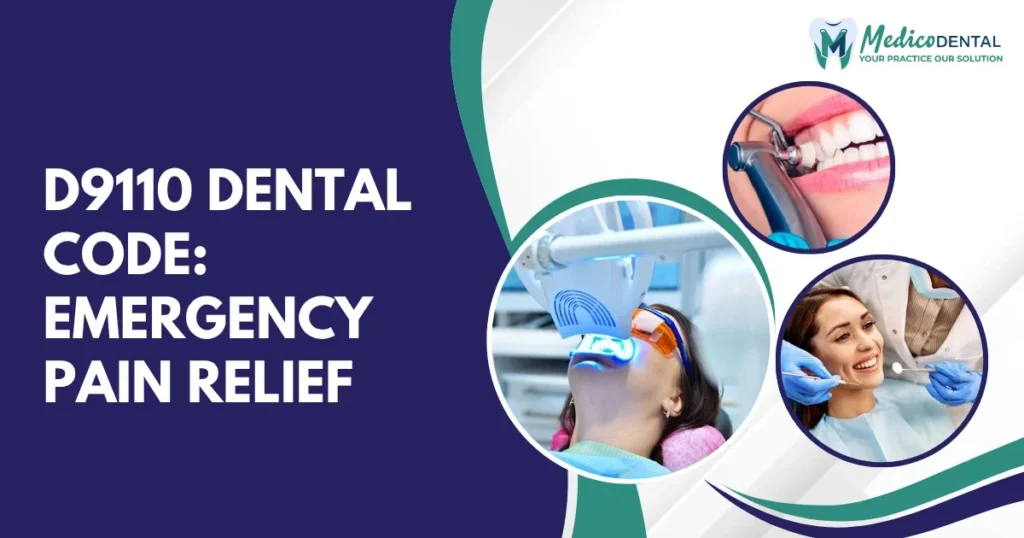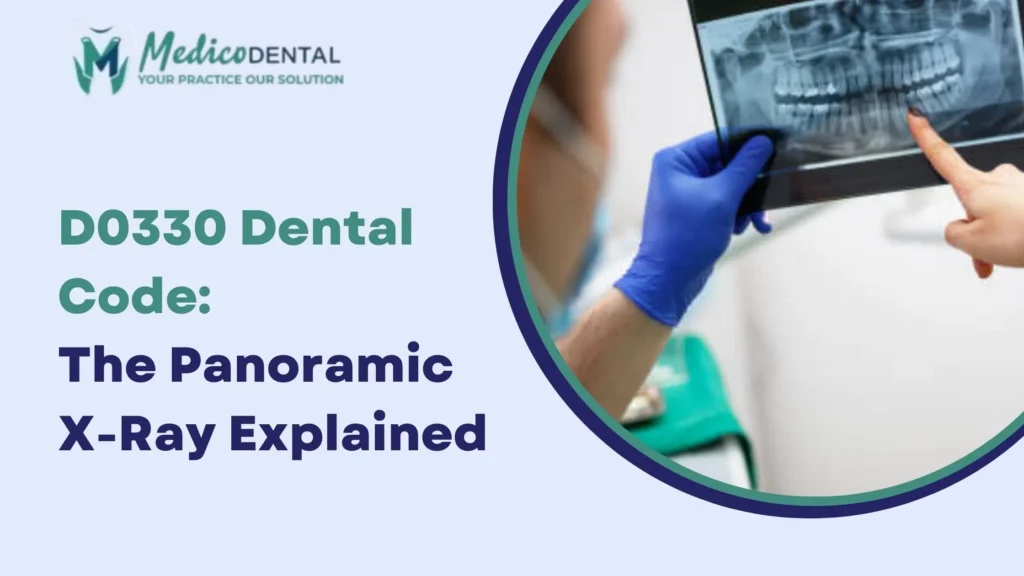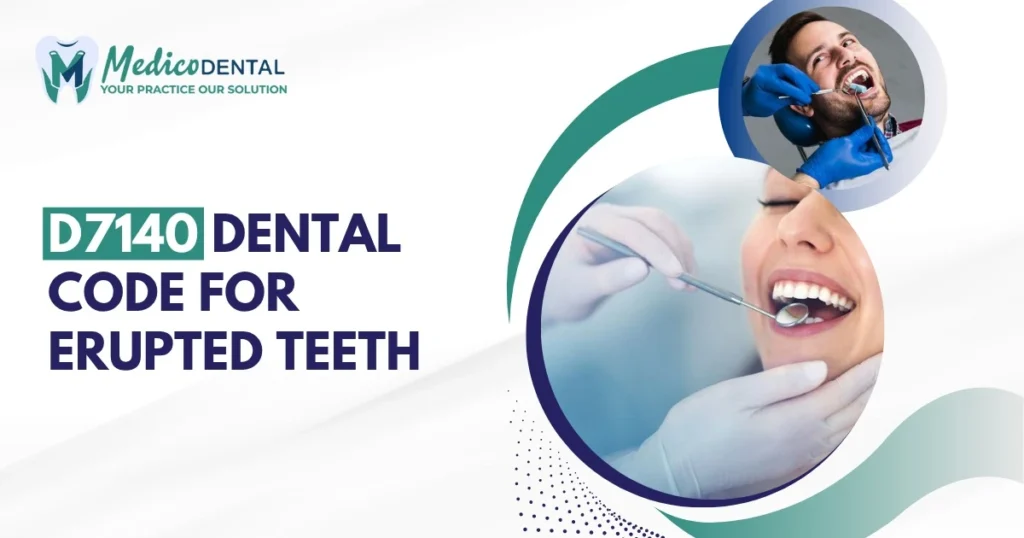The D9110 dental code refers to palliative (emergency) treatment of dental pain, a minor procedure used to provide immediate relief for patients experiencing acute dental discomfort. This code is primarily used in emergency settings where patients require urgent care to manage pain, but it does not address the root cause of the problem. After this temporary intervention, follow up treatment is typically required for definitive care.
Overview of the D9110 Dental Code
D9110 is part of the Current Dental Terminology (CDT) codes maintained by the American Dental Association (ADA) and is used specifically for emergency dental procedures aimed at alleviating pain. This code is typically used when a patient visits a dental office seeking relief from pain caused by issues such as broken teeth, abscesses, or sharp tooth edges. It’s important to understand that while D9110 provides quick relief, it does not serve as a solution to the underlying dental issue, which will need to be addressed in follow up visits.
Importance of Understanding Emergency Palliative Care Codes
Knowing the D9110 dental code is vital for dental professionals as it helps ensure proper billing and patient care. It clarifies when and how to treat patients experiencing pain and ensures that both the patient and the dental office are prepared for the next steps in treatment. Understanding this code helps prevent confusion and guarantees the right procedures are applied, facilitating proper insurance claims and effective care.
What Does D9110 Cover?
Pain Relief and Emergency Care
The primary purpose of D9110 is to relieve immediate dental pain. This can include providing temporary solutions to help the patient manage their pain until they can receive more permanent care. Whether the pain is caused by a cavity, a cracked tooth, or an abscess, D9110 ensures that patients can temporarily find relief in emergency situations.
Minor Procedures Included in D9110
Temporary Fillings
If a tooth is cracked or decayed and the damage is causing pain, D9110 allows the dentist to place a temporary filling to prevent further discomfort. This is not a permanent solution but a temporary fix until the patient can return for more definitive treatment.
Abscess Drainage
In cases where a dental abscess is the source of pain, D9110 can cover the procedure to drain the abscess. This is necessary to relieve pressure and alleviate pain but requires follow up treatment to address the underlying infection.
Smoothing Sharp Tooth Edges
For patients with broken or chipped teeth, D9110 allows the dentist to smooth the sharp edges that could otherwise cause irritation to the mouth, gums, or tongue. Again, this is a short term solution to ease discomfort.
Applying Topical Anesthetics
If necessary, a dentist may apply a topical anesthetic to the area around the painful tooth or gums to reduce the pain temporarily. This can be particularly helpful in emergency situations to manage immediate pain before a more thorough examination or procedure can take place.
Removing Impacted Food Particles
In some cases, food particles can get stuck between teeth or in gums, leading to discomfort and swelling. D9110 allows for removal of impacted food particles, helping to relieve the immediate pain.
Follow up Care Requirements
While D9110 can alleviate pain, it is important to note that it requires follow up. This code is not intended to be used as a permanent solution but as a stopgap to get the patient through an emergency situation. Follow up appointments are necessary to perform the definitive treatments, such as fillings, root canals, or extractions.
What D9110 Does Not Cover
Definitive Treatments Excluded from D9110
D9110 is not a substitute for definitive care. It is only meant to address pain temporarily, not to fix the underlying issue causing the discomfort. The following procedures are excluded from coverage under D9110:
Root Canals
A root canal, which is a procedure to treat the infection inside the tooth, is not covered by D9110. If a root canal is needed, it will require a separate treatment code and a follow up appointment.
Extractions
While D9110 may temporarily relieve pain caused by an infected or damaged tooth, it does not cover extractions. If the tooth needs to be removed, it will be treated separately with its own appropriate code.
Permanent Fillings
D9110 is not for the placement of permanent fillings. Temporary fillings may be placed to alleviate pain, but a follow up visit will be necessary to place a permanent filling.
Standard Exams and D0140
D9110 is distinct from a standard dental exam (such as D0140, which is a problem focused exam). Although a problem focused exam may be necessary alongside D9110, they are separate codes and should be billed accordingly.
When to Use D9110 in Dental Practices
Indications for Palliative Treatment
D9110 is used when patients come in for palliative care due to acute pain caused by dental issues like broken teeth, abscesses, or food impactions. It’s important to use this code when the primary goal is to manage pain temporarily, allowing the patient to feel relief until definitive care can be provided.
Emergency Scenarios Requiring D9110
Typical emergency situations that require D9110 include:
- Severe tooth pain due to fractures, cavities, or abscesses
- Post trauma pain where immediate relief is necessary
- Sharp edges of a broken tooth that cause irritation or discomfort
- Food impaction causing swelling or sharp pain
By identifying these scenarios, dental professionals can quickly and effectively apply D9110 to ensure patient comfort and prepare them for follow up care.
Billing and Coding for D9110
Billing and coding for the D9110 dental code is essential for proper reimbursement and efficient dental practice management. The D9110 code represents palliative (emergency) treatment for dental pain, and it’s crucial to use it correctly to avoid billing errors and ensure proper payment for emergency care. Here’s a comprehensive guide on how to bill for D9110 and some common mistakes to avoid.
How to Bill for D9110
Billing for D9110 follows the standard process for dental codes, but with a focus on emergency care. When a patient comes in for pain relief due to issues like a broken tooth, abscess, or food impaction, D9110 is used to cover the temporary procedures that provide pain relief.
To bill for D9110, follow these steps:
Verify the Need for Emergency Care: Before billing for D9110, confirm that the patient is seeking palliative care for acute dental pain. This code is not meant for routine visits or preventive care.
Document the Procedures: Proper documentation is critical. Record the minor procedures performed, such as applying a temporary filling, draining an abscess, or smoothing sharp tooth edges. Documentation should be thorough, including notes about the patient’s symptoms, the procedure performed, and any follow up recommendations.
Use the Correct Code: When submitting the insurance claim, ensure you use D9110 for the emergency care provided. If other procedures or exams are conducted alongside D9110, they must be billed separately with their respective codes.
Submit with Correct Dates: Since D9110 is a temporary solution, you may need to submit follow up procedures (e.g., root canal or extraction) after the emergency treatment. Ensure that the follow up visits are billed separately and include their respective dates and codes.
Combining D9110 with Other Codes (e.g., D0140)
In many cases, D9110 may be billed alongside other codes, particularly when a problem focused examination (D0140) is performed in addition to the emergency care. Here’s how you can combine D9110 with other codes:
- D0140 – Problem Focused Exam: If the patient requires an exam to diagnose the underlying issue causing the pain, you can bill for both D9110 and D0140. The D0140 code covers the problem focused examination, while D9110 covers the emergency treatment. Ensure both codes are billed correctly based on the services provided.
- Other Related Codes: If additional procedures are required, such as placing a temporary filling (D2950) or performing a routine x ray (D0220), these can be added to the claim as separate items.
Important Note: Make sure to follow up with the proper treatment plan, using the correct codes for procedures that address the root cause of the problem, such as root canals (D3320), extractions (D7140), or permanent fillings (D2391).
Insurance and Coverage Considerations
Insurance companies typically cover D9110 if the patient’s pain is deemed to be a true emergency. However, coverage can vary based on the patient’s plan, location, and the specific insurance company. Here are a few important insurance related considerations:
Verify Coverage: Before treatment, it’s essential to verify with the insurance provider whether they will cover the D9110 procedure. Some insurance companies may have restrictions on emergency care or may require a higher co pay for palliative treatments.
Co Payments and Deductibles: Some insurance policies may require the patient to pay a portion of the treatment cost through co pays or deductibles. Ensure the patient understands the cost of their visit to avoid confusion later.
Palliative Care Limitations: Many insurance providers limit the frequency of palliative care procedures they will cover per year. Be aware of these limitations when billing multiple D9110 claims for the same patient.
Out of Network Providers: If the patient is receiving care from an out of network provider, their insurance may only cover a portion of the treatment. Ensure the patient is informed of potential out of pocket expenses.
Common Mistakes to Avoid When Using D9110
Billing errors can delay payment or result in claim denials. To avoid common mistakes when using D9110, here are some things to watch out for:
Misuse of D9110 for Definitive Treatment
One of the most common errors is using D9110 for procedures that are intended to be definitive treatments. D9110 is strictly for emergency palliative care and should not be used for routine procedures like root canals, extractions, or permanent fillings. If a patient needs one of these treatments, a separate code should be used, and D9110 should not be billed.
Incorrect Billing Practices
- Overbilling: Some dental offices mistakenly bill D9110 for multiple visits when only one emergency procedure was performed. Ensure that each D9110 claim is linked to a valid emergency treatment.
- Underbilling: Ensure you are billing all relevant services. For example, if a problem focused exam (D0140) was performed alongside the D9110, it should be billed as a separate service. Don’t forget to include all appropriate codes for any additional procedures performed during the emergency visit.
- Not Documenting Properly: Adequate documentation is essential. If a procedure is performed, like draining an abscess or applying a temporary filling, be sure to document it clearly in the patient’s file. Incomplete documentation may result in denials from the insurance company.
Conclusion
D9110 plays a crucial role in providing emergency dental care for patients in acute pain. It allows dental professionals to temporarily alleviate discomfort while ensuring patients return for the necessary definitive treatment. Proper billing and coding for D9110 ensure that dental offices receive appropriate reimbursement and that patients are not burdened by unexpected costs.
The D9110 dental code is designed for immediate, emergency palliative care, offering relief from dental pain in situations like abscesses, broken teeth, or sharp tooth edges. It is not a replacement for permanent solutions but helps stabilize the patient until follow up care is completed.
Accurate coding for D9110 ensures that emergency dental procedures are properly billed and reimbursed, preventing delays and errors in payments. By following proper coding guidelines and avoiding common mistakes, dental offices can streamline their billing processes and focus on delivering effective care.
FAQs
Common Questions About D9110 Dental Code
What types of procedures does D9110 cover?
Ans. D9110 covers minor, emergency procedures like temporary fillings, abscess drainage, smoothing sharp tooth edges, and applying topical anesthetics.
Can D9110 be billed with other codes?
Ans. Yes, D9110 can be billed with other codes like D0140 for a problem focused exam or codes for additional procedures like x rays or temporary fillings.
How often can D9110 be billed?
Ans. Insurance companies may limit the number of times D9110 can be billed within a certain time frame, so it’s important to check the patient’s coverage.
Does D9110 cover permanent fillings?
Ans. No, D9110 does not cover permanent fillings or definitive treatments like root canals or extractions. It is strictly for temporary pain relief in emergencies.
Is D9110 a substitute for a routine dental exam?
Ans. No, D9110 is for emergency care, and it is separate from routine exams, such as D0140.



